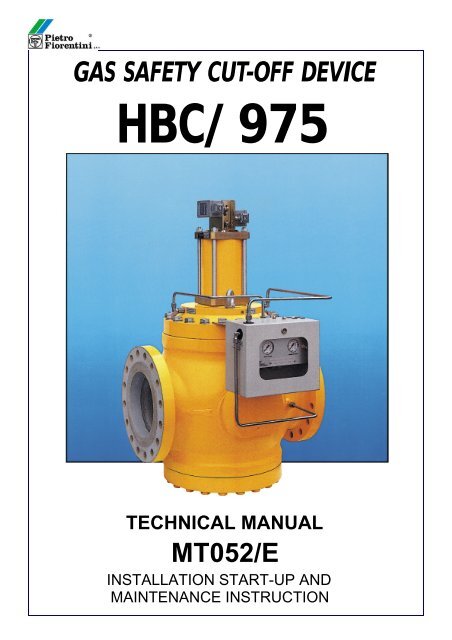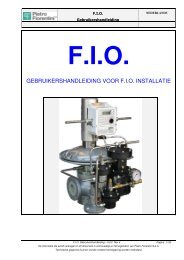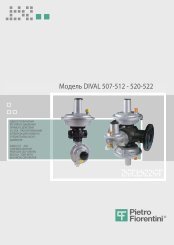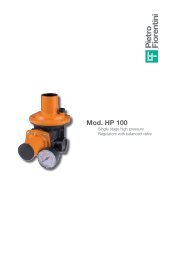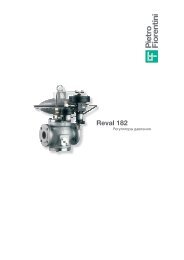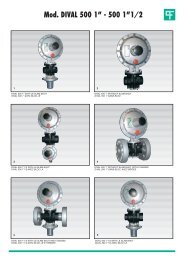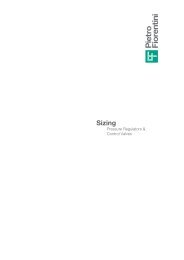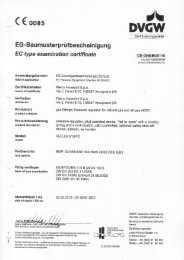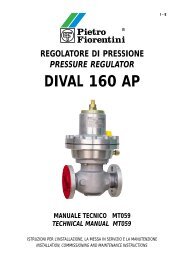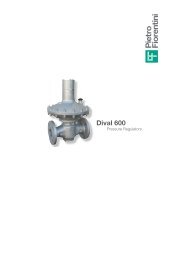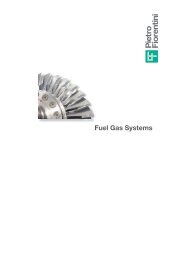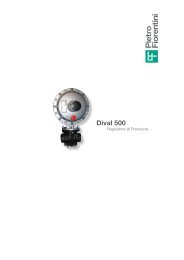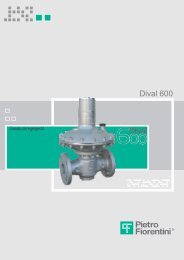HBC/975 - Pietro Fiorentini
HBC/975 - Pietro Fiorentini
HBC/975 - Pietro Fiorentini
Create successful ePaper yourself
Turn your PDF publications into a flip-book with our unique Google optimized e-Paper software.
GAS SAFETY CUT-OFF DEVICE<br />
<strong>HBC</strong>/<strong>975</strong><br />
TECHNICAL MANUAL<br />
MT052/E<br />
INSTALLATION START-UP AND<br />
MAINTENANCE INSTRUCTION
GENERAL PRECAUTIONS<br />
- The apparatus described in this manual is a device<br />
subject to pressure installed in systems under pressure;<br />
- the apparatus in question is normally installed in<br />
systems for transporting flammable gases (natural<br />
gas, for example).<br />
PRECAUTIONS FOR THE OPERATORS<br />
Before proceeding with installation, commissioning or<br />
maintenance, operators must:<br />
- examine the safety provisions applicable to the<br />
installation in which they must work;<br />
- obtain the authorisations necessary for working<br />
when so required;<br />
- use the necessary means of individual protection<br />
(helmet, goggles, etc.);<br />
- ensure that the area in which they operate is fitted<br />
with the means of collective protection envisaged<br />
and with the necessary safety indications.<br />
HANDLING<br />
The handling of the apparatus and of its components<br />
must only be carried out after ensuring that the lifting<br />
gear is adequate for the loads to lift (lifting capacity<br />
and functionality). The apparatus must be handled<br />
using the lifting points provided on the apparatus itself.<br />
Motorised means must only be used by the persons in<br />
charge of them.<br />
INSTALLATION<br />
If the installation of the apparatus requires the application<br />
of compression fittings in the field, these must be installed<br />
following the instructions of the manufacturer of<br />
the fittings themselves. The choice of the fitting must be<br />
compatible with the use specified for the apparatus and<br />
with the specifications of the system when envisaged.<br />
COMMISSIONING<br />
PRECAUTIONS<br />
Commissioning must be carried out by adequately trained<br />
personnel.<br />
During the commissioning activities, the personnel not<br />
strictly necessary must be ordered away and the no-go<br />
area must be properly signalled (signs, barriers, etc.).<br />
Check that the settings of the apparatus are those<br />
requested; if necessary, reset them to the required<br />
values in accordance with the procedures indicated in<br />
the manual.<br />
When commissioning, the risks associated with any<br />
discharges into the atmosphere of flammable or<br />
noxious gases must be assessed.<br />
In installations in natural gas distribution networks, the<br />
risk of the formation of explosive mixtures (gas/air)<br />
inside the piping must be considered.
Packing for transportation of equipment is<br />
designed and shaped to avoid damage to any part<br />
during handling activities. After packing is open,<br />
check that no damage occurred to equipment. If<br />
damage occurred inform manufacturer and keep<br />
packing for any verification.<br />
Shut off valve <strong>HBC</strong> <strong>975</strong> with pressure<br />
switches for overpressure and underpressure may<br />
be employed as pressure accessory or safety<br />
accessory according to directive 97/23/EC.<br />
Conformity to Directive 97/23/FC and CE<br />
marking of valve and relevant accessory<br />
requires installation on system with minimum<br />
requirements according to:<br />
EN 12286- EN 12279<br />
Pressure valve does not require any safety<br />
accessory installed upstream for protection<br />
against overpressure compared with design<br />
pressure PS, when reducing station installed<br />
upstream is sized for a max downstream<br />
incidental pressure MIPd < 1,1 PS.<br />
Valve, when installed on a reducing station<br />
must be installed at least according to<br />
requirements of standard EN 12186 and EN<br />
12279.<br />
All venting connection shall be connected as<br />
required by above mentioned standard.<br />
PRECAUTIONS<br />
CONFORMITY TO DIRECTIVE 97/23/EC (PED)<br />
installation. If equipment is employed as safety<br />
accessory, internal tightness shall be verified at a<br />
pressure value of 1,1XPS.<br />
Both verifications are essential to maintain CE<br />
marking.<br />
Periodical inspection and maintenance shall be<br />
carried out according to standard and laws in<br />
force (kind and period).<br />
Before commissioning of equipment after<br />
maintenance, external tightness shall be verified<br />
at a pressure value equal to valu e available on
1. DESCRIPTION 5<br />
1.1 Main features 5<br />
1.2 Fields of application and operation 5<br />
1.3 Operation 6<br />
1.3 Settings 7<br />
2. INSTALLATION 9<br />
2.1 General 9<br />
3. COMMISSIONING 11<br />
3.1 General 11<br />
3.2 Checking the setting 13<br />
3.3 Commissioning 14<br />
4. ACCESSORIES 14<br />
5. TROUBLE-SHOOTING 15<br />
6. MAINTENANCE 16<br />
6.1 General 16<br />
6.2 Disassembly 16<br />
7. COMPONENTS AND SPARE PARTS LIST 19<br />
2
EDITION 2/2002<br />
3
Fig. 1<br />
4
1. DESCRIPTION<br />
The <strong>HBC</strong> <strong>975</strong> gas safety cut-off device is an apparatus which blocks the flow of gas if the<br />
controlled pressure reaches the set-point for its intervention, or if actuated manually.<br />
1.1 Main features<br />
The valve is suitable for medium and high pressures.<br />
The main features of this valve are:<br />
- Gas cut-off in both directions<br />
- Balanced valve obturator<br />
- Indirect, self-fed, pneumatic actuation<br />
- Intervention for minimum and/or maximum pressure<br />
- Adjustable closing speed from 0.5 to 2 sec.<br />
- Local close button<br />
- Incorporated bypass<br />
- Manual reset only<br />
- Easy maintenance without removing body<br />
- Highly reliable internal parts<br />
- Possibility of build-in on Reflux and Aperflux regulators<br />
1.2 Fields of application and operation<br />
- Non-corrosive filtered gas<br />
- Design pressure : 100 bar<br />
- Working temperature: from -10° to +60°C (-20°+60°C on request)<br />
- SH 11 90 control devices<br />
- Intervention for maximum pressure: 1 – 85 bar<br />
- Intervention for minimum pressure: 0.4 – 75 bar<br />
5
1.3 Operation<br />
The cut-off device consists principally of the following parts<br />
- on/off valve (12)<br />
- single action pneumatic actuator<br />
- line-off device<br />
When there is no pressure, the valve obturator is held in the closed position by the spring,<br />
pos. (13), and rests on the valve seat. The seal is guaranteed by the contact between the<br />
obturator and the valve seat. The control pressure is obtained by taking off gas at pressure Pe<br />
directly upstream from the valve. The gas passes through the valve (1) (which can deviate<br />
the pressure towards the downstream piping through a bypass line) and, appropriately<br />
filtered by the filter (2), enters the pressure regulator(4), the purpose of which is to stabilize<br />
the control pressure to the valve (4 bar); this can be checked on the pressure gauge(3). The<br />
stabilized gas enters the pneumatic valve 3/2 (8) and then passes to the actuator(11). When<br />
the actuator is filled, the valve opens.<br />
6
1.3 Settings<br />
Setting springs<br />
table TT 984<br />
7
table TT 985<br />
8
2. INSTALLATION<br />
2.1 General<br />
The <strong>HBC</strong> <strong>975</strong> cut-off device is always supplied complete with nipple for the sensing line.<br />
Before installing the valve you must ensure that:<br />
- the valve can be inserted in the space provided and that there is enough room for later<br />
maintenance operations<br />
- the piping upstream and downstream is at the same level and capable of supporting the<br />
weight of the valve; if it is not, fit appropriate supports<br />
- the inlet/outlet flanges on the piping are perfectly parallel<br />
- the interior of the mouths of the valve are clean and the valve has not suffered damage<br />
during transport<br />
- the upstream piping as far as the filter has been cleaned so as to expel residual<br />
impurities such as welding slag, sand, paint residues, water, etc.<br />
When the above controls have been carried out, the valve can be fitted in line, making sure<br />
that the body is oriented so that the flow is in the direction shown by the arrow impressed on<br />
the body itself.<br />
For proper regulation, it is indispensable for the downstream sensing line to be connected to<br />
a rectilinear stretch of the downstream piping itself with a length in accordance with the<br />
table and with a maximum gas speed at the take-off point not exceeding 30 m/sec.<br />
The valve closing pressure switch command is generated by comparing the pressure in the<br />
line, which can be read on the pressure gauge (10) and the setting springs (minimum and/or<br />
maximum) of the SH 11-90 pressure switch device. When the ratio of the comparison<br />
deviates from the maximum value (or lower in the case of minimum setting) the pressure<br />
switch device moves the pneumatic control lever which discharges the gas from the<br />
obturator control chamber through the dumper (7). The spring (13) closes the valve(12). The<br />
valve can also be closed by mechanical movement by pressing the button (9B).<br />
The valve can only be reset manually by means of the reset pomel of the SH 11-90 valve. To<br />
prevent the accumulation of impurities and condensate in the sensing line, it is<br />
recommended that:<br />
- the sensing line should always descend towards the nipple on the downstream piping<br />
with a slope of about 5 –10%<br />
- the downstream piping nipple must always be welded to the top part of the piping itself.<br />
The most common types of installation for the <strong>HBC</strong> <strong>975</strong> cut-off device are shown in figures<br />
2 and 3.<br />
9
Figure 2 shows installation in a pressure regulation line; figure 3 shows installation on a<br />
generic trunk.<br />
10
3. COMMISSIONING<br />
3.1 General<br />
After installation, check that:<br />
- the inlet/outlet on/off valves and the bleed cock are closed<br />
- the cut-off device is closed.<br />
The open-closed situation can be seen from the position of the open-closed indicator on the<br />
head of the pressure switch control.<br />
The cut-off device is normally supplied already set at the required value but, for safety<br />
reasons, setting should be repeated in accordance with the procedure illustrated in the<br />
paragraphs which follow.<br />
ATTENTION: check that the conditions of use comply with the characteristics of the cut-<br />
off device before commissioning. These characteristics are shown by the symbols on the<br />
plates applied on every apparatus. Table 1 on page 12 lists the symbols used and their<br />
meanings.<br />
Consult table TT984-TT985 for the recommended set-point.<br />
- external tightness is guaranteed if no visible leakage when a foam medium is applied<br />
on the element under pressure<br />
- the internal tightness of an element which separates two chambers under different<br />
pressures is guaranteed when the pressure in the closed chamber with the lower<br />
pressure remains stable for a period of no less than 15 minutes taking account of the<br />
temperature variations.<br />
11
table 1<br />
Some symbols employed on these name plates are described here below<br />
Pemx = max inlet working pressure<br />
Who = intervention range of tripping unit in the event of overpressure. It may<br />
be obtained by using the set point springs shown in the applicable<br />
Wao =<br />
tables TT984-TT985<br />
intervention range of ripping unit in the event of overpressure. It may<br />
be obtained by means of the set point spring installed by P.<strong>Fiorentini</strong><br />
Whu =<br />
during the testing<br />
intervention range of tripping unit in the event of underpressure. It<br />
may be obtained by changing the set point springs as shown in the<br />
applicable tables TT984-TT985<br />
Wau = intervention range of tripping unit in the event of underpressure. It<br />
may be obtained by means of the set point springs installed by<br />
P.<strong>Fiorentini</strong> during the testing.<br />
12
3.2 Checking the setting<br />
Check as follows that the set-point of the cut-off device has the value desired:<br />
- separately connect the control head to a controlled auxiliary pressure<br />
- press the provided button to trip the cut-off device to the closed position<br />
- slowly open the on/off valve V1 upstream from the cut-off device with consequent<br />
pressurization of the line upstream from the cut-off device<br />
- position the three-way valve (1) in the bypass position and pressurize the line<br />
downstream from the cut-off device<br />
- ensure that the pressures above and below the valve are balanced<br />
- actuate the pressure switch reset knob (9B)<br />
- position the 3-way valve (1) in the working position<br />
- control the cut-off device opening through the provided indicator<br />
- stabilize the value of the auxiliary pressure at a lower value than the maximum<br />
pressure intervention point or between the maximum and minimum values when<br />
setting up for both types of intervention<br />
- reset the cut-off device device using the provided knob and:<br />
♣ for safety devices which intervene for upper pressure: slowly increase the<br />
auxiliary pressure and check the trip pressure value; if necessary, increase the trip<br />
pressure value by turning the adjustment ring clockwise, or anticlockwise to reduce<br />
the intervention value.<br />
♣ for safety devices for upper and lower: slowly increase the auxiliary pressure and<br />
record the trip pressure value. Restore the auxiliary pressure to the initial value, and<br />
carry out the cut-off device reset operation. Check intervention for pressure<br />
reduction by slowly reducing the auxiliary pressure.<br />
13
3.3 Commissioning<br />
- Trip the cut-off device mechanically to the closed position by pressing the provided<br />
button.<br />
- Slowly open the on/off valve V1 upstream from the cut-off device with consequent<br />
pressurization of the line upstream from the valve.<br />
- Operating manually, position the 3-way valve in the bypass position and slowly<br />
pressurize the line downstream from the cut-off device and control the flanged and<br />
threaded seals in the section<br />
- Ensure that the pressures upstream and downstream the valve are in equilibrium<br />
- Actuate the reset knob (9B) of the pressure switch with consequent activation of the SH<br />
11-90 pneumatic device.<br />
- Turn the lever of the 3-way valve (1) slowly to the work position.<br />
- Control the opening of the cut-off device through the provided indicator<br />
4. ACCESSORIES<br />
The following can be applied to the valve, on request:<br />
- valve and/or closed signalling microswitch<br />
- emergency system with remote control<br />
The system can also be built-in on Reflux and Aperflux regulators.<br />
14
5. TROUBLE-SHOOTING<br />
PROBLEM POSSIBLE CAUSES REMEDY<br />
The cut-off device obturator<br />
does not close<br />
Leakage from the cut-off device<br />
obturator<br />
Clogging of discharge nozzle of<br />
pneumatic valve 3/2.<br />
Rupture of the diaphragm (4) or<br />
O-ring (4) of the measuring<br />
head<br />
Obturator seal (7) deteriorated.<br />
O-rings (87) (88) deteriorated<br />
Obturator seat (71) worn or<br />
scratched<br />
Incorrect trip pressure Incorrect setting of max and/or<br />
min spring<br />
Friction<br />
Leakage from GACO ring of<br />
the pneumatic control<br />
Not possible to reset The reason for increase or<br />
decrease of pressure<br />
downstream persists<br />
Broken linkage<br />
No pressure after pneumatic<br />
resetting<br />
Clean<br />
Replace<br />
Replace<br />
Replace<br />
Grind or Replace<br />
Reset by means of the<br />
adjustment ring<br />
Clean<br />
Replace<br />
Checks the causes<br />
Replace the SH 11-90<br />
pressure switch<br />
Replace filter cartridge<br />
15
6. MAINTENANCE<br />
6.1 General<br />
Before any maintenance operation, discharge the pressure as follows:<br />
a) close the upstream on/off valve V1<br />
b) close the downstream on/off valve V2<br />
c) check that the cut-off device is open<br />
d) very slowly discharge the pressure through the bleed cock to the atmosphere (6)<br />
In the event of intervention for minimum pressure, discharge the pressure upstream from the<br />
valve by turning the 3-way cock (1) to the bypass position.<br />
6.2 Disassembly<br />
Before starting the disassembly operations, it is necessary to check that:<br />
- the valve has been cut off upstream and downstream and that the pressure between the<br />
two on-off valves has been discharged<br />
- you have a set of spanners as specified in the table<br />
- you have the recommended set of spare parts<br />
Depending on the type of problem which has occurred, maintenance may involve:<br />
a) the on/off valve<br />
b) the single action pneumatic actuator<br />
c) the line-off device<br />
a) On-off valve<br />
It is possible to remove the cut-off device valve without disconnecting the body from the<br />
piping.<br />
- disconnect all the feed and sensing line connections, by unscrewing all the conical seal<br />
connections<br />
- slacken the fixing screw of the LINE OFF system support bracket<br />
- slacken the fixing screw pos. (32) and remove the cut-off device device<br />
- slacken the nuts pos. (33) fixing the obturator pos. (71) to the rod pos.(6)<br />
- remove the obturator pos.(71)<br />
- relaxe completely the spring pos. (80) unscrewing the locknut pos.(9)<br />
- remove the spring pos.(80)<br />
- slacken the fixing screws pos. (86) and remove the obturator guide pos.(72)<br />
- slacken the fixing screws pos. (89) of the lock ring pos. (8) of the reinforced gasket<br />
16
pos.(7)<br />
- remove the lock ring pos. (8) and the reinforced gasket pos.(7)<br />
- control and clean the metal parts<br />
- carefully control the state of the obturator valve seat<br />
- replace all the components in the spare parts kit<br />
Single action pneumatic actuator<br />
- unscrew the nut pos. (60) and remove the stroke reference ring pos. (59)<br />
- slacken the fixing nuts pos. (67) and remove the flange pos. (74)and the plating<br />
pos.(75)<br />
- remove the balancing piston pos.(15)<br />
- keeping the spacer pos. (69) firm, unscrew and remove the balancing rod guide pos.<br />
(11)<br />
remove the piston pos. (65) and the spacers pos. (69) and (19)<br />
- slacken the fixing screws pos.(27)<br />
- separate the flange pos. (73) from the cover pos. (70)<br />
- remove the rod guide pos. (20) from the cover pos. (70)<br />
- replace all the components in the spare parts kit<br />
b) Line-off device<br />
Filter<br />
- -slacken the cup pos. (1) and remove from cover pos. (2)<br />
- slacken the screw pos. (5)and remove the filter cartridge pos.(4)<br />
- replace all the components in the spare parts kit<br />
R91 pressure regulator<br />
- slacken the locknut pos.(17)<br />
- turn the adjusting screw pos. (15) anticlockwise to slacken to the end of its stroke<br />
- slacken the screws pos. (23) and remove the sleeve pos.(14), the spring support<br />
pos.(16), the spring pos. (21) and the diaphragm holder assembly<br />
- unscrew the locknut pos. (22) from the diaphragm support pos. (11) and remove the<br />
spring support pos. (13) and the diaphragm pos.(10)<br />
- unscrew the plug pos. (1) and remove the spring support pos.(6), the spring pos.(20),<br />
the lock ring pos.(7), the obturator pos. (8) and the reinforced gasket pos.(3)<br />
17
- replace all the components in the spare parts kit<br />
VS/FI bleed valve<br />
- unscrew the plug pos.(3), discharge the spring pos. (4) and remove the obturator<br />
pos.(2)<br />
- carefully check the state of the valve seat<br />
- replace all the components in the spare parts kit<br />
Pressure switch device type SH1190 type 104<br />
- disconnect the signal take-off<br />
- slacken the fixing screws pos. (43)<br />
- remove the cover pos. (2)<br />
- replace all the components in the spare parts kit<br />
NOTE: After cut-off device intervention, close the on/off valves upstream and<br />
downstream and discharge the pressure. The cut-off device must never be<br />
actuated before remedying the problem that caused it to trip.<br />
18
7. COMPONENTS AND SPARE PARTS LIST<br />
19
I dati sono indicativi e non impegnativi. Ci riserviamo di apportare eventuali modifiche senza preavviso.<br />
The data are not binding. We reserve the right to make modifications without prior notice.<br />
<strong>Pietro</strong> <strong>Fiorentini</strong> S.p.A.<br />
UFFICI COMMERCIALI:<br />
OFFICES:<br />
I-20124 MILANO Italy - Via Rosellini, 1 - Phone +39.02.6961421 (10 linee a.r.) - Telefax +39.02.6880457<br />
E-mail: sales@fiorentini.com<br />
I-36057 ARCUGNANO (VI) Italy - Via E. Fermi, 8/10 - Phone +39.0444.968511 (10 linee a.r.) - Telefax +39.0444.960468<br />
E-mail: arcugnano@fiorentini.com<br />
I-80143 NAPOLI Centro direzionale - Isola G 1 Phone +39.081.7500499 - Telefax +39.081.7500394<br />
E-mail: napoli@fiorentini.com<br />
ASSISTENZA POST-VENDITA E SERVIZIO RICAMBI:<br />
SPARE PARTS AND AFTER-SALES SERVICE:<br />
I-36057 ARCUGNANO (VI) - Italy - Via E. Fermi, 8/10 - Phone +39.0444.968511 (10 linee a.r.) - Telefax +39.0444.968513 - E-mail: service@fiorentini.com


